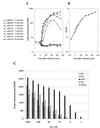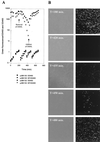gfp-based N-acyl homoserine-lactone sensor systems for detection of bacterial communication
- PMID: 11157219
- PMCID: PMC92623
- DOI: 10.1128/AEM.67.2.575-585.2001
gfp-based N-acyl homoserine-lactone sensor systems for detection of bacterial communication
Abstract
In order to perform single-cell analysis and online studies of N-acyl homoserine lactone (AHL)-mediated communication among bacteria, components of the Vibrio fischeri quorum sensor encoded by luxR-P(luxI) have been fused to modified versions of gfpmut3* genes encoding unstable green fluorescent proteins. Bacterial strains harboring this green fluorescent sensor detected a broad spectrum of AHL molecules and were capable of sensing the presence of 5 nM N-3-oxohexanoyl-L-homoserine lactone in the surroundings. In combination with epifluorescent microscopy, the sensitivity of the sensor enabled AHL detection at the single-cell level and allowed for real-time measurements of fluctuations in AHL concentrations. This green fluorescent AHL sensor provides a state-of-the-art tool for studies of communication between the individuals present in mixed bacterial communities.
Figures






References
-
- Chalfie M, Tu Y, Euskirchen G, Ward W W, Prasher D C. Green fluorescent protein as marker for gene expression. Science. 1994;263:802–805. - PubMed
-
- Clark D J, Maaløe O. DNA replication and the division cycle in Escherichia coli. J Mol Biol. 1967;23:99–112.
Publication types
MeSH terms
Substances
Grants and funding
LinkOut - more resources
Full Text Sources
Other Literature Sources
Molecular Biology Databases

